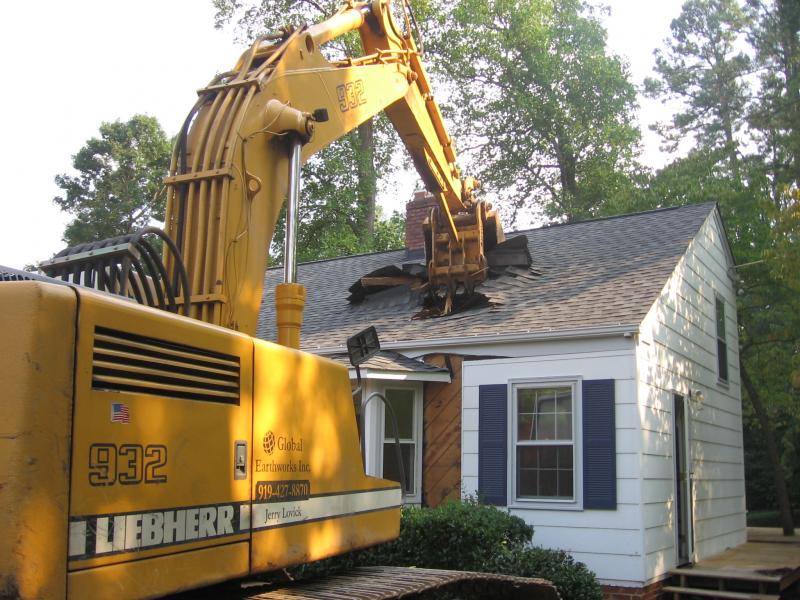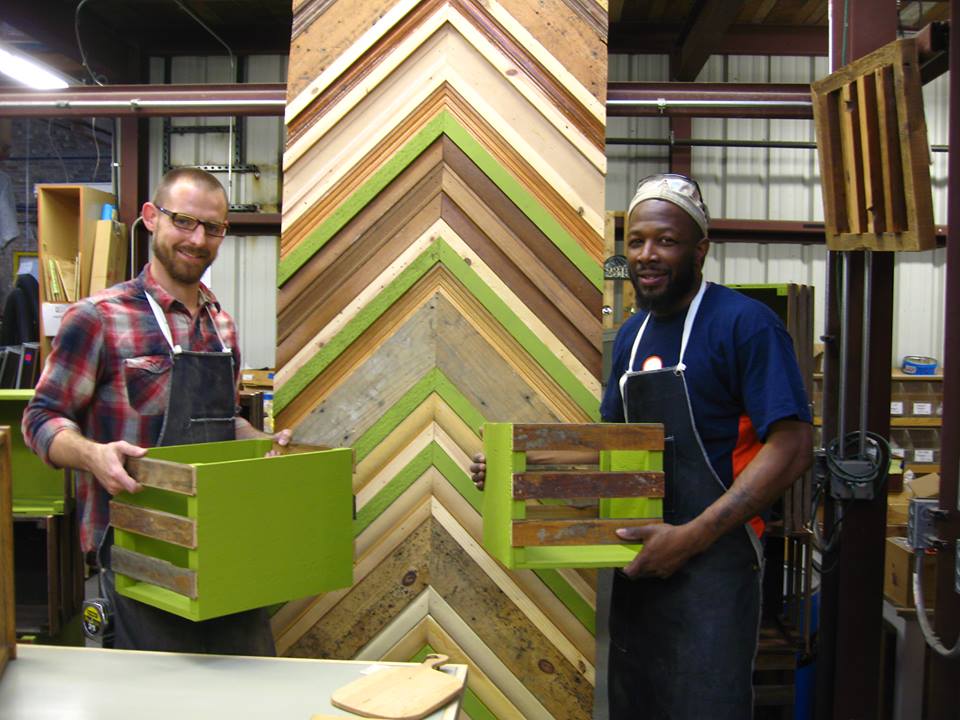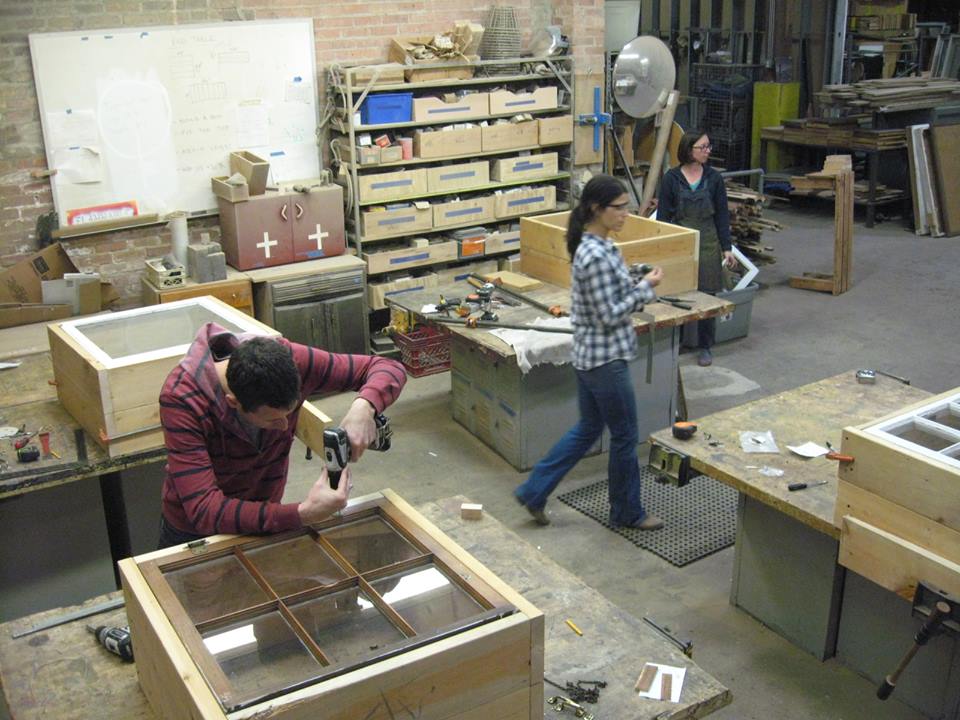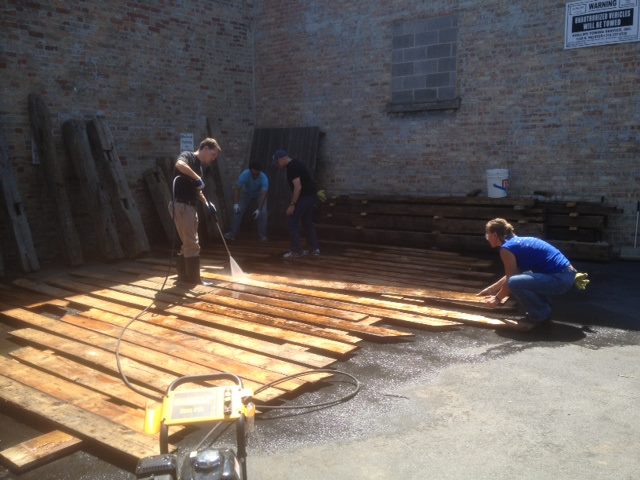
Elise Zelechowski is executive director of the ReBuilding Exchange (RX), a Chicago-based organization that diverts used building materials – the source of 40% of America’s solid waste stream – away from landfills by promoting sustainable “deconstruction” practices which allow it to reclaim lumber and other raw materials from demolition and remodeling sites and make them available to the public for reuse.
An initiative of Chicago’s Delta Institute, a nonprofit founded in 1998 to promote economically sound environmental policy, RX also offers workshops on creative reuse, forums for contractors and other professionals, and job training for people transitioning out of the criminal justice system. An expert on all things garbage, Zelechowski spoke about the need to rethink the waste stream, the economic and environmental impacts of creative reuse, and how making trash visible is key to making it manageable.
Origins of the ReBuilding Exchange
Martha Bayne: You came into all of this from an environmental perspective, not necessarily from a social justice perspective or an architectural salvage perspective. What’s your academic background?
Elise Zelechowski: French philosophy [laughs]. I went to Evergreen. Going to school there you can’t leave without being pretty well-rounded as an environmentalist, a feminist, a social justice advocate. And then I lived in France and I was really taken by how the city of Paris functions in terms of food infrastructure, transit infrastructure, small business and recycling. And [it’s] of necessity because they’ve got narrow streets and have had to troubleshoot for so long. We have all these luxuries – wider streets, truck bays – so I was fascinated by how Paris worked.
I lived there for two years and then moved back to Chicago and got a job with the city in the Department of Environment. Chicago was just starting its green building [work], and for all of Mayor Daley’s quirks he was a huge advocate of sustainability. I was working on theChicago Center for Green Technology and we were figuring out how to bring sustainability resources to Chicago residents. I got asked about salvage material a lot. In terms of building products, it’s the most environmentally responsible way to go – as long as you’re getting it locally and you’re not having to send it through a re-manufacturing process.
I also have always had very strong feelings about the incarceration system in this country, so making job training at the RX focus on people transitioning out of the criminal justice system was my own doing. I said that if we’re going to train people, there are so many people who are facing insane challenges trying to get their lives together, let’s try and give them access to this economy.
Deconstruction vs. Demolition: Foreclosures and Financing
MB: I was watching your TED talk and two things leaped out at me. One was the connection between our waste stream and poverty: how waste processing disproportionately affects low-income communities, especially in cities. And then the idea of visibility: making waste visible, making poverty visible, making job training visible, and making the effort in all these areas visible as an educational tool. People working in climate change struggle with that as well – making it visible, because it can be such an abstract concept for so many reasons.
EZ: Absolutely. The ReBuilding Exchange is a tangible demonstration of climate change intervention. You can come in and do this action that’s very real and tangible, and you feel empowered. It’s definitely a store, and it’s definitely a workshop, but it helps that the building we are in is beautiful – it’s dramatic and skylit, it's a thought-provoking and spiritual place to be.
One thing that is really visible right now, that we’re not sure how to deal with, are all the foreclosures that have been left neglected for three or four years. These buildings are falling down, neighbors want these houses down, and they’re being demolished in the thousands. The emotional dimension of that – the loss for the neighborhood of all these buildings, the loss of architectural history, is really sad.
Deconstruction isn’t going to save that house in place, but there’s something interesting about the materiality, the slow process of deconstructing versus crushing something, which is so immediate and aggressive and intense. Taking something apart in this way where you respect each piece adds another dimension to it. We’ve had neighbors come and talk to us when we’re doing field deconstruction-training and actually speak to that. There’s a respect in the process that’s noticeable to other people.
MB: How do you get that to happen? Do you have contractors or demolition people who you have relationships with?
EZ: Well, there’s three “buckets.” We try to work with government or quasi-governmental agencies that have control over large portfolios of properties, like land banks, because there’s an economy of scale to this. Deconstruction takes longer and so it costs more, but because you’re saying to a contractor, “You’re going to do 100 houses,” you can flex a little muscle and get a more competitive bid.
Then there are the demo contractors. They are no-bullshit; time is money. When you’re working with them, usually full deconstruction is not an option. So we’re looking at hybrid [strategies]: how to, say, at least take the top section off with an excavator, then we can take the beams and the top infrastructure of the building by hand.
And the third [group is] people who are mission-driven to fully deconstruct their houses. Typically that means that they can pay more. They can take a tax-deduction for donating the materials, and sometimes that will help even out the cost.
Creative Reuse: Making Waste Visible
The other half of what we do in terms of material salvage is renovations. People will put in $10,000 kitchens to sell their house, and then the person who buys it will take it right out. People get rid of white laminate cabinets all the time, and beautiful vintage cabinets. And there’s always someone who will either reuse that as is or have some creative idea for how to repaint, redesign, or rework it. Every time a donation of material comes in you have to find the right buyer for it.
MB: It seems like the slow pace of deconstruction and the market issues could really work in your favor in terms of making things visible, because you have time to get the message out.
EZ: An ideal deconstruction would take a couple of weeks and you’d have time to really inventory the materials and find markets. Last year, Delta helped the county pass an ordinance that’s only relevant in suburban Cook – the city hasn’t opted in yet – but that requires 70% diversion on all commercial and residential demolitions. Diversion can include reuse on-site or off-site, recycling on-site or off-site. And specifically in residential projects, 5% of that 70% has to be reuse. It was the county’s first step in addressing this growing waste problem we have that nobody seems to be taking very seriously.
MB: What do you think is the biggest challenge to rethinking the waste stream?
EZ: Lack of visibility! There’s this sense that there’s this “away” place for garbage, in the same way that we put prisoners “away,” or poor people “away,” so that we don’t have to deal with it. And then from a resource perspective, in terms of raw material extraction, the way we value that is really screwed up.
Waste management companies are basically logistics companies. They pick up and then they drop off. They are not in the business of trying to innovate recycling markets. They want to find brokers who will then aggregate different material-streams and who will find manufacturers to use the material. But unless there’s some driver forcing the hand of a manufacturer to use recycled metal or recycled paper in their processing …
MB: You need to find some incentive, so it’s not just something people should do because it feels good.
EZ: Right, because they’re just going to be, like, “Who cares?” The other big challenge is that we contaminate our materials when we put them all in the same place. Separating things down to the smallest piece is actually the best goal for organizing the system, because even if it’s overkill, it’s forcing you to have a thought process about how much material you’re using and what you’re using it for. And then we need to pay the real costs of landfilling.
MB: Which are?
EZ: Well, you rarely see waste programs by household that charge you based on how much waste you produce. [Processors] try to extract as much value as they can, but the more that [waste] is commingled and messy, it’s going to be a real pain in the butt to make it cost-effective to separate the green glass from the brown glass, etc.
But in terms of impact, look at landfills, waste-to-energy plants, anywhere you’re doing waste-processing: they’re all in low-income neighborhoods. And the way incentives are set up, landfills pay host fees to the municipalities, and the fees are often based on how much they’re able to take. I believe it creates a perverse incentive to be a huge landfill.
There’s one landfill in Cook County, [with] a year left of life. The county is freaking out because there’s a ban on new landfills and the existing capacity is almost zero. The city of Dalton tried to leave [Cook] County so that they could open a landfill in their community, because they saw it as economic development.
MB: What’s the economic base of Dalton?
EZ: It’s low-income. And both Gary and Detroit have looked at waste-to-energy in terms of economic development. It’s an interesting question for municipalities that are looking to attract the waste industry for whatever reason – they have the space, the real estate is cheaper, they have the labor force. [But] what kind of waste-processing will drive the most jobs? What will drive the most environmental and economic impact? The recycling and reuse industry creates seven jobs for every one job at a landfill, because it’s processing-intensive.
But people through the supply chain don’t want to [front] those costs unless the end-user is paying. People who are processing waste are adding value, but until the person at the end of the value-chain says, “I can pay that,” what’s the alternative? That’s why RX takes this holistic approach: we don’t believe you can do just one of these things in isolation. You’re changing a system, so you have to look at all these different leverage-points. If you try to push one really hard you won’t be able to bring the others into balance.
MB: It seems like a no-brainer, but what are the negatives that are disproportionately affecting low-income neighborhoods? Is it air quality and pollution? Methane emissions?
EZ: All those things. Right now Delta is studying the environmental impacts of waste transportation through the region, [like] pollution – leakage and stuff leaching into the ground water, material blowing off the top of the landfill, methane escaping. There’s a lot of focus on methane capture. Also, it’s just such a poor land-use idea.
Learning from Egypt’s Recyclers
I was in Cairo in April with the Zabaleen people, the Coptic Christians who have been the city’s informal garbage collectors for over 100 years. There’s a really cool movie about them called Garbage Dreams. They have this system based on family units and they all have different zones in the city. They pick up by small trucks – they used to do it by donkey – and they bring all the recyclables back and sort in their homes. They’re able to achieve insanely high recycling rates. They’ll take all the plastic and separate it down to the tiniest piece, then they’ll run it through machines that extrude it and turn it into pellets, and then they sell it to brokers, who in turn sell it to China.
The entire Zabaleen economy is based on this. But of course their overhead is very low because they don’t have a fancy plant, they don’t have OSHA standards, they’re not wearing masks and gloves when they sort the garbage. They’re able to manage their costs because they don’t take on all these regulatory requirements, which in some cases are very important in terms of public health.
MB: Do you see a way to integrate the fine-grained work of sorting by hand with safety standardization in the U.S.?
EZ: ReBuilding Exchange. No, seriously. When we first started we had to GIVE lumber away. Now people are hungry for it. They see the value, it’s gorgeous, they love working with it. All the hip new restaurants are all over it.
MB: Tori Marlan wrote a story once about brick salvage and the informal economy of these down-and-out guys who would salvage and sell old Chicago bricks, which were a hot commodity among builders because they were such a higher quality than newer bricks. Any thoughts about how upcycling and reuse could mitigate against global warming and related problems? The super-macro picture?
EZ: We have to figure out more localized infrastructure that allows us to get resources that we’re done with back into the value-stream. That’s why we included the word “exchange” when we named [the RX] – this is a place that we want things to come in and out of. And that only really works at a local level. It gets back to visibility.
The Big Picture: Climate Change, Capitalism, Sweden and Beyond
I got to go on these waste tours when I was in Europe in October. In Malmo, Sweden, they have recycling centers in every single neighborhood. I went to one where my friends live, and there were at least 100 people there at 2 o’clock on a Sunday; it was just part of how people organized their weekend. That’s what we need: physical infrastructure that allows us to organize these resources, and citizen [participation]. And we need to drive behavior toward that, whether it’s incentives, regulation or whatever. You get a bin that’s this small [makes a not-large cube with her hands], if you fill it up you pay more, or you have to go to the recycling station and dump it yourself. On job-sites for construction or demolition you have separate bins for all your materials. It’s just part of how you do business.
MB: I once lived on Washington Island, in Wisconsin, and it’s pretty conservative in many ways. It’s not Sweden. But their waste management, because it’s an island, is extremely sophisticated. There isn’t this idea that you can send something away. Everyone goes to the dump and everything gets sorted, brown glass, clear glass, green glass; paper over here, toxic chemicals over there. It wasn’t coming out of ideology, it was coming from a practical place of understanding their limitations.
EZ: Exactly. In Stockholm they have tracking codes on the bins, and if your bin weighs more than X kilos, they send you a bill. And people understand that if you buy something it becomes your responsibility through the duration of its life. It changes the way you purchase and the way you think about what you bring into your home. It changes the way they package and sell things.
They’re also big proponents of waste-to-energy, which is highly contentious here. I mean, they’re burning trash. They use waste-to-energy to heat about 90% of the houses in Malmo. Their argument is that the alternative is to burn fossil fuels, so the emissions are much lower in burning garbage.
What’s interesting about their model, though, is that they’re cooperatively owned by 14 municipalities. They’re a public entity, so they don’t have to make a profit, and they were able to invest in the most expensive flue-gas scrubbing technology, so their emissions are one-fiftieth of what they’re permitted to emit. They sell their waste-power into the grid, but they have an agreement with the grid-operator that if they don’t want to sell, they don’t have to. If there’s an opportunity to innovate the recycling-stream and divert garbage from the waste-to-energy plant, they will do that instead – because ultimately they are trying to get to a zero-waste, high reuse-and-recycling rate, and move away from burning. But while they have the trash they would rather do that than landfill it.
It’s real-time decision-making about what the highest and best use is in the context that they’re given. They don’t want landfills, they need energy, and they’re trying to innovate. How do you deal with all these constraints and come up with something flexible enough to react?
MB: Something that’s not driven by its own needs.
EZ: Yeah, because it’s not driven by profit they have flexibility. As long as they pay back the capital costs they can stand to innovate.
MB: Oh, Sweden.
EZ: Talking big picture about climate strategy, you need systems that are flexible and adaptable, where you’re able to make informed decisions. Our systems are very rigid, because capitalism is very rigid. We have to create systems that have the flexibility that the southern Sweden program does. They are very forward-thinking. We need more on-the-ground models that provide a local resource. And Chicago doesn’t seem to be moving that way, unfortunately, so we need more market-making entities like RX to pop up.
3 WAYS TO SHOW YOUR SUPPORT
- Log in to post comments

















